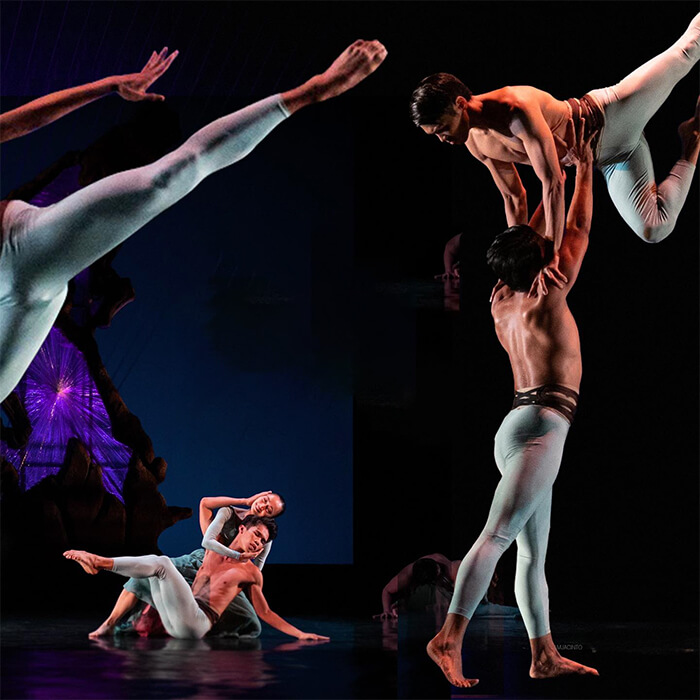Can dance be thought-provoking?
Taking off from Alice Reyes Dance Philippines’ first performance for 2024 is another iconic work by National Artist for Dance Alice Reyes, set to explode onstage on June 14 and 15 at the Samsung Performing Arts Theater.
Apart from Alice Reyes’ Carmina Burana, the main piece for the night included in the evening’s repertoire are three diverse works by Reyes, Norman Walker, and Agustus Damian.
Yet another collaboration with fellow National Artists, Reyes, together with National Artist for Music Dr. Ramon Santos and National Artist for Theater Design Salvador Bernal, reinterprets Dugso, a tribal dance from Bukidnon in northeastern Mindanao, based on a young man’s initiation ritual as dictated by a tribal priest with the entire tribe participating in the final offering. Reyes’ movements are inspired by its tribal dance origins, like the graceful hand movements by female dancers called kubay and the complex footwork, translated into contemporary movements.

Summer’s End was choreographed by Walker, an early collaborator of Reyes, and one of the foremost modern dancers and choreographers of his generation. He became director of Jacob’s Pillow for five seasons. Jacob’s Pillow is a dance school cited by The New York Times as “the dance center of the nation,” lauded worldwide as “a hub and mecca for dancing.”

Walker retired after his term there, but his company continued to perform, just as he did not stop teaching and choreographing dance works all around the world. Among those countries was the Philippines, where his work Summer’s End, a romantic pas de deux, premiered at the CCP in 1980. It is choreographed for three pairs of dancers, each with specific interpretations, as they are danced either en pointe, in soft shoes or barefoot. A pas de deux in the romantic tradition, the piece demonstrates the joys of love and romance and the painful bitterness of longing and parting.
After a dancing career of 20 years in Europe as a soloist or principal company dancer in various companies, including Maurice Bejart’s Bejart Ballet Laussane, and performing in six different leading theaters, Augustus “Bam” Damian returned to the Philippines and became the artistic director for Ballet Philippines, not only honing the dancers’ technique but also choreographing several contemporary pieces that are now part of ARDP’s repertoire.
Among these is After Whom? At first sight, it is a contemporary abstract showcase for the dancers. The title’s premise is that, in some cultures, women walk behind the men by tradition, indicating subservience to the men. The dance opens with the men tormenting the women. The dance progresses to the second movement, where a lone woman stands at center, surrounded by men, until she cries out, “Music!”—exhibiting a woman’s right to speak out loud. The men surround her approach with aggression as she fights back. The women’s movements become more intense as five couples perform a pas de deux. A provocateur encourages the intensity of conflict between both sexes. The dancers’ costumes are reminiscent of movie post-love scenes where the male is shown with a white towel wrapped around his waist and the woman, skirt-less, wears the man’s white shirt.
In the denouement a woman is lifted, indicating importance and triumphant equality, a position exactly the same as the men at the start. Ending the piece, both men and women come back in the coda with men supporting men, and women supporting women.

The music for After Whom? (entitled Nuevas Cruzes) was composed by the French group Von Magnet, formed in 1985 and known for its post-industrial music, which they describe as “electroflamenco.” It incorporates the various flamenco compás with additional influences of Middle Eastern strains. In Damian’s version, award-winning composer and film director Jerrold Tarog reconfigures the music, keeping to the measures and counts of the original piece, but infused with hints of Filipino ethnicity.
Gleaned from a 700-year-old manuscript, the cantata Carmina Burana (Songs of Beuern) is composed of 315 profane songs. Of these, the German composer Carl Orff chose 24, organized into four sections that he calls “scenic cantatas,” envisioned as “a stage work with singing and dancing choruses.” The lyrics are in secular Latin, Middle High German, and Old French, and are practically all profane.
The piece opens with a clash of cymbals and drums signaling the prologue, followed by ominous music chords. Alice Reyes’ choreography sits tightly with the music throughout; the dancers’ movements are executed in strong angular thrusts to complement the repetitive chords with an underlying syncopation mimicking the turning of a wheel in the opening. The opening verses have the choir almost screaming at the goddess of Fortune: “O Fortuna velut luna statu variabilis…” (“O Fortune, like the moon you are changeable...”)
Although the music can sound clerical and serious, Carmina Burana was in fact written by a group of monks who narrate bawdy incidents and situations, resonating with earthy humor, the joys of life, the sadness of desperation, the fickleness of fortune and wealth, as the Wheel of Fortune—a medieval metaphor describing a path of life for each person—spins and assigns each a destiny devoid of biases.
Carmina Burana has become so popular perhaps because of the simple, repetitive and insistent rhythms, its themes connecting early medieval poetry to the present. The dramatic and gripping dance interpretation by Reyes outlines those struggles with oppression, fear, desperation, joys of love, moral ambiguity, situations experienced in the past and still as relevant today. Carmina Burana’s popularity is such that, between 2024 and 2025, it will be showcased in 80 countries, the Philippines among them.
This second season offering of Alice Reyes Dance Philippines guarantees an evening well spent, as various aspects of life are interpreted in the art form that best expresses the silent screams, whether joyful or anguished: dance.
* * *
Carmina Burana runs on June 14, 7:30 p.m. and on June 15 at 2:30 and 7:30 p.m. at the Samsung Performing Arts Theater, Makati Circuit. Tickets are available at Ticketworld, or from Alice Reyes Dance Philippines (0967-1536173).


